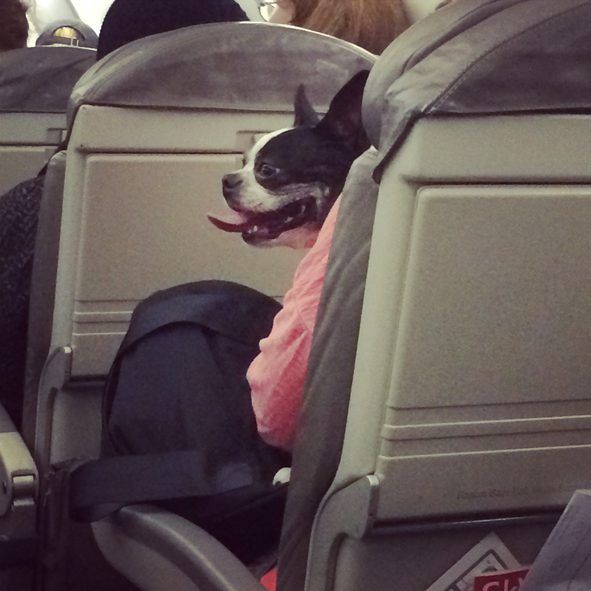If you have flown anywhere lately, you are likely aware that there are many dogs flying with their owners these days. Take a stroll down any airline terminal, and you will see a number of dogs strolling on leash with their owners—and quite a few behaving in ways that are quite uncharacteristic of trained service dogs. I’ve seen dogs relieving themselves in airline terminals, barking or growling at other dogs, pulling on their leashes, and panting and showing other signs of stress.
I have chalked all of this up to the fact that so-called Emotional Service Animals (ESAs) were permitted to fly with their owners on airplanes for free, and that more and more people were willing to call their pet dogs an emotional service animal. But I was unaware until recently that in March 2021, after a lengthy public comment period and analysis, the Department of Transportation (DOT) changed the rules in its Air Carrier Access Act (ACAA) concerning emotional service animals (ESAs) on airplanes. At least when it comes to air travel, ESAs have been reclassified as pets, with no greater rights or privileges on airplanes as any other pets. Today, only service dogs—dogs who have been individually trained to do work or perform tasks for the benefit of a person with a disability—can fly with their owner outside of a pet carrier.
Undoubtedly, some owners who previously claimed that their dogs were emotional service animals are now claiming that their dogs are service dogs, trained to perform specific tasks if they detect their owner is having or about to have a psychiatric challenge or crisis. Owners of a psychiatric service dog must now submit forms to the airline they plan to travel with, attesting to their service animal’s health, behavior, and training.
As daunting as that may sound, a person who just really wants to fly with their reasonably well-behaved dog in the cabin with them will not find it difficult to lie on these forms—though I must mention that the forms state at the top, “It is a Federal crime to make materially false, fictitious, or fraudulent statements, entries, or representations knowingly and willfully on this form to secure disability accommodations provided under regulations of the United States Department of Transportation.”
I love seeing calm, well trained service dogs in public—and I hate seeing stressed dogs who are clearly being pushed past their comfort zone being dragged through public places. I find it hard to believe that there at genuinely that many people with trained psychiatric service dogs traveling by air, but maybe I am just flat wrong.
What’s your experience with dogs in airports and on airplanes?







I’m confused about how the author is identifying psychiatric service dogs. Is she assuming that any dog with someone without a visible disability is a PSD? Why doesn’t she mention seizure alert and diabetic alert dogs? Both of which are probably more common than the PSDs.
I agree with the premise that many people probably cheat. But the rest of the article almost comes across as bashing psychiatric service dogs.
As a handler-trainer of a psychiatric service dog, I completely agree! I felt that my psychiatric service dog was being bashed.
That is very disheartening because many, even within the service dog community itself, think psychiatric service dogs are not legitimate service dogs. Some of these people have even actively sought to restrict the rights of psychiatric service dog handlers!
We have had to fight to be treated the same as any other service dog handler and yet, the fight continues…
I have a therapy dog, a Shiba who is calm, doesn’t bark and knows many voice and hand commands. I would not lie on federal forms and even for us, who would like to be able to fly together to distant places, I’ve never presumed the idea that Tachi is a service dog. I would not put him in cargo! I, too, find it irritating to see ESD’s in public places who are obviously not trained at all. It’s a slap to those who have carefully trained dogs who help them through life.
I agree with Ms Snyder that there are other reasons people would want to have their dog close and safe for both. I imagine science will find that dogs have other talents in time.
There is no such thing as an ESA. That’s a pet, period. A PSD is a Service Dog and has the same legal rights as other Service Dogs to go wherever the handler who NEEDS their assistance goes. PSDs do perform specific tasks that can be life-saving. This article does a great disservice to people who have invisible disabilities which their PSDs are essential in managing. A printed correction to this article is in order.
Your comment that you have a hard time believing that many real PSDs are flying is flippant and ignorant. Just because you can’t see a person’s disability or see how the dog is performing tasks doesn’t mean that the team is fake. Without data on how many PSD teams fly, you are impugning a large population of disabled persons, adding to stigma, and making it harder for all service dogs to accompany their handlers. I believe that it’s illegal for any establishment, even airlines, to require proof of service dog legitimacy. Please print the research.
Also, legitimate Service Dogs of any kind are living, evolving, fallible beings, and even though they are trained, they may behave unpredictability when faced with the chaos of air travel, especially when PETS are misbehaving around them. Please withhold your judgment about PSAs and their handlers.
I too have a Certified Therapy Dog. A full size Aussidoodle. In order to be certified we passed 2 tests 100%, did 10 annotated visits, had a background check done, and submitted a 22 page application about me and the dog. Bailey has his Canine Good Citizen, his Novice and Intermediate Trick Dog Ribbon, does Agility and Rally. He goes 3-4 times a week to a facility to brighten people’s day.
I say all this because I do take issue with people who just say their dog is a certain type so they can sidestep the rules.
Now there are sites that will “register” any pet as a service animal, helping people to get around the restrictions without any due regard for the rights or safety of other passengers.
People with genuine disabilities, whether psychiatric, diabetic, vision impaired, or what have you, most certainly should and are permitted to bring their vital companions along in the passenger cabin. They are expensively trained, highly skilled animals, and any minor inconvenience their presence might bring to other travelers is more than justified by the essential nature of their work with their stewards.
But only those dogs. We love our boys, travel with them (on the ground), and would love to take them to places inaccessible or too distant by road, but recognize that imposing them on the others sharing the cabin, terminal, shuttle or what have you, is a selfish and unjustified indulgence. I am allergic, for instance, to the dander of shedding animals, and having a cat’s hair floating around in the closed-loop circulation of an aircraft aloft is an excessive price for ME to pay for your desire to have Mr. Whiskers go everywhere with you.
Genuine service animals have documentation, and are equally obvious just by the manner in which they conduct themselves while in busy and confusing situations. Our pets lack either distinction.
CW
Per the ADA, service animals are not required to have documentation or proof of certification.
You are not allowed to:
Request any documentation that the dog is registered, licensed, or certified as a service animal
There are individuals and organizations that sell service animal certification or registration documents online. These documents do not convey any rights under the ADA and the Department of Justice does not recognize them as proof that the dog is a service animal.
However, your comment regarding behavior is definitely a valid point. I hate going places and seeing someone with a “service dog” that is not well behaved or has some indication that it is in training.
Further, the acronym ESA, as misused as it is, has never meant Emotional SERVICE Animal. It breaks out to Emotional SUPPORT Animal. That’s why it is deemed illegitimate under federal law. That’s why it causes so much confusion regarding the rights of legitimate Service Dogs, because the terms sound the same to most people. You have perpetuated this confusion.
A small step in the right direction could be to do away with the separate designation PSD for legitimate Psychiatric Service dogs, and call all Service Dogs SDs, regardless of the handler’s disability or the dog’s tasks.
Now I am getting confused. By definition:
“ What Is an Assistance Animal?
An assistance animal is an animal that works, provides assistance, or performs tasks for the benefit of a person with a disability, or that provides emotional support that alleviates one or more identified effects of a person’s disability. An assistance animal is not a pet.”
I believe now you are trying to split frog hairs and confuse things even more. An assistance animal may provide emotional support. How then does it not fall into the definition of a subset of assistance animals specifically as an ESA?
They are not trying to split hairs. You need to know how definitions work between various federal laws. The one you quote for “assistance animal” comes from federal housing law and only relates to issues dealing with housing law/discrimination. It does not control the definition of “Service Animal” or what access service animals are allowed – that is defined by the Americans with Disabilities Act (ADA) – or what animals are allowed on airplanes – that is governed by the Federal Aviation Administration (FAA). An “assistance animal” does include an emotional support animal; however, a service dog does not include all assistance animals.
I’m so thankful ESAs are no longer allowed on planes. My golden retriever was a therapy dog at a hospital. She was calm, never barked, ignored other dogs, unphased by loud noises- a rare “bomb proof” dog. I had people tell me “If that was my dog I’d take her into the grocery store! Everyone would think she was a service dog!” That really bothered me. I would have loved to have her with me to run my errands but all that does is hurt credibility for folks with actual service dogs that NEED their dog with them.
I agree with your thoughts. A trained service dog is expected, by the general public, to behave in a certain way. If it is unrulely or behaving inappropriately it is either not a trained service dog or needs further training. I once saw a “trained” hearing dog try to bit a person walking by him. To me that dog was not a properly trained service animal.
Nancy with all due respect I think your blog both hits a vein a further stigmatizes guardians that require service dogs. Based on the comments my thought is your blog both requires retraction/correction and those with unseen disabilities. Why narrow it down as you have done!
The Department of Justice administers the Americans with Disability Act. That’s where the rules and regulations can be found. The rules were SPECIFICALLY written to avoid both breaches under HIPPA and DO NOT allow questions as to the handlers disability.
Two questions and two questions only are able to be asked:
1) Is the dog a service animal required because of a disability?
and
2) What work or task has the dog been trained to perform?
That’s it. There is no paperwork, registry, vest, or anything else required. The airline rules are a separate topic for the DOT/FAA and are more restrictive.
My frustration is as a puppy raiser for Guide Dogs. 5-10 years ago I would routinely bring puppies in training on work trips requiring air travel. Of course this was towards the end of the dogs’ time with me, as they were reliable and comfortable with most situations. Air travel was one that is not easily simulated in any other way and there was a noticeable increase of comfort from the first trip to the 3rd or 4th. Currently the TSA paperwork requires a signed affadavit that the dog is a ‘fully trained service animal’ and I can’t attest to that since the dog is technically in training, so the last 2 years I have not brought dogs on the plane with me. How is a dog supposed to get exposure? There is always going to be that first trip, and better that any problems arise prior to working with a handler who has an impairment. It’s always wonderful to walk off of a plane, or out of a restaurant, when someone comments ‘I had no idea that dog was with you’ because they were so well behaved. There has to be an answer. I just don’t know what it is!!
The psychiatric Service Dog must be well trained, and as such will not pull at the leash, obeys commands, ignores other dogs, etc. just like any other service dog. Perhaps when an airline employee asks “what is the dog trained to do for you?” (the only question allowed) the airline employee thinks that dog is an emotional support dog. A letter from an M.D. and the required Dept. of Transportation form helps, even if it is a nuisance. I have a service dog for my neurodegenerative disorder and have never had anything but total acceptance on the airlines. My dog, Abby, has had 82 airplane flights. She is a yellow Labrador and they always seat us in “preferred comfort” seats, where she can lie down comfortably in front of me.
I do agree that an “almost fully trained” service dog SHOULD be able to fly.